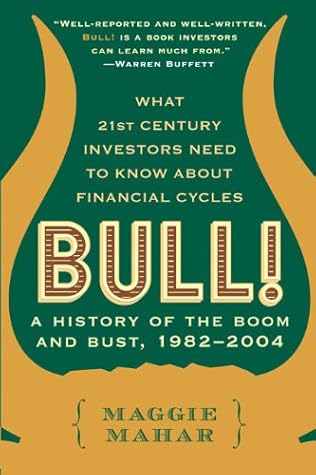More on this book
Kindle Notes & Highlights
by
Maggie Mahar
Read between
November 13 - November 16, 2020
skeptical view
Jim Chanos,
E...
This highlight has been truncated due to consecutive passage length restrictions.
“window dr...
This highlight has been truncated due to consecutive passage length restrictions.
“Sarbanes-Oxley makes corporate fraud a crime,” Chanos observed, referring to the 2002 legislation that required CEOs to sign off on their company’s financial statements.
Earnings that winked at you were not the only signs of a frothy market.
In December of 2003, one portfolio manager summed up the quality of this new bull market: “If you had told me that the market was going to be led this year by small, low-priced stocks of money-losing companies,”
colu...
This highlight has been truncated due to consecutive passage length restrictions.
unpert...
This highlight has been truncated due to consecutive passage length restrictions.
Even as individual investors surged into stocks, insiders headed for the exits: in March of 2004, insiders sold $23.38 of their own stock for every $1 that they bought.
fund managers
“Most money managers are participating in this crazy market, but many do not believe in it,” Fred Hickey, editor of The Hi-Tech Strategist, observed in February.
Younger momentum investors had taken their places, and many were gunslingers. “They’re speculators,” Hickey noted, “with their fingers on the sell triggers.”
THE SHAPE OF THINGS TO COME
From the sidelines, Richard Russell cast a cold eye on the rebound that began in the spring of 2003, warning his readers that the rally was nothing other than a bear market rally—otherwise known as a “sucker” rally: “The sharpest and most explosive rallies occur not in bull markets but in bear markets,” Russell observed.
“As the old-time Dow Theorists were fond of saying, ‘a bear market rally often looks better than the real thing.’ That saying came about,” Russell added, “following the giant b...
This highlight has been truncated due to consecutive passage length restrictions.
the crash of 1970
January of 1973, the Dow had hit a new high, and Alan Greenspan, then an informal advisor to President Nixon, was among those convinced that the bull was back: “It is very rare that you can be as unqualifiedly bullish as you can be right now,” he declared at the very beginning of the year.14 Within weeks, the crash of 1973-74 began.
This second leg down would prove far more traumatic than the first: when it was all over, the Dow had erased ...
This highlight has been truncated due to consecutive passage length restrictions.
But while history may repeat, it always repeats w...
This highlight has been truncated due to consecutive passage length restrictions.
Gail Dudack
Steve Leuthold
a new bottom—or a...
This highlight has been truncated due to consecutive passage length restrictions.
Leu...
This highlight has been truncated due to consecutive passage length restrictions.
1974
This highlight has been truncated due to consecutive passage length restrictions.
1982
This highlight has been truncated due to consecutive passage length restrictions.
precrash ...
This highlight has been truncated due to consecutive passage length restrictions.
2004
This highlight has been truncated due to consecutive passage length restrictions.
2005,
“Market timers and asset allocators could do pretty well in this type of market,” he added. “But this is not a market for buy-and-hold stock investors.” As Leuthold knew from experience, “buy-and-hold” works only in long “secular” bull markets.
Most individual investors, however, did not distinguish between short, “cyclical” bull markets—which can easily turn into bear traps—and the real McCoy, “secular” bull m...
This highlight has been truncated due to consecutive passage length restrictions.
As far as most 401(k) investors were concerned, the bull was back, and they did not...
This highlight has been truncated due to consecutive passage length restrictions.
Leu...
This highlight has been truncated due to consecutive passage length restrictions.
CDs,
Treasuries
As Leuthold put it, “stocks are the only g...
This highlight has been truncated due to consecutive passage length restrictions.
CONSUMERS LEAD THE RECOVERY
Conservative investors who wanted to tuck their savings away in a bond and watch it compound complained about rock-bottom rates.
administration’s ...
This highlight has been truncated due to consecutive passage length restrictions.
Only a few weeks before the Fed’s thirteenth cut, President Bush signed legislation to reduce taxes by $350 billion, bringing the administration’s total 10-year tax cut package to a generous $1.7 trillion.
The Greenspan/Bush administration’s plan was to boost demand by putting more cash into consumers’ hands.
Short...
This highlight has been truncated due to consecutive passage length restrictions.
Consumers were not simply spending their tax refunds; they were spending money that they did not have.
By 2003, U.S. consumers had increased their spending for an unprecedented 47 quarters in a row.
felt wealthier.
2003
2003,
43 trillion—
the spring of 2000.19
In other words, the nation’s shopping spree was driven, not by jobs and rising incomes,


